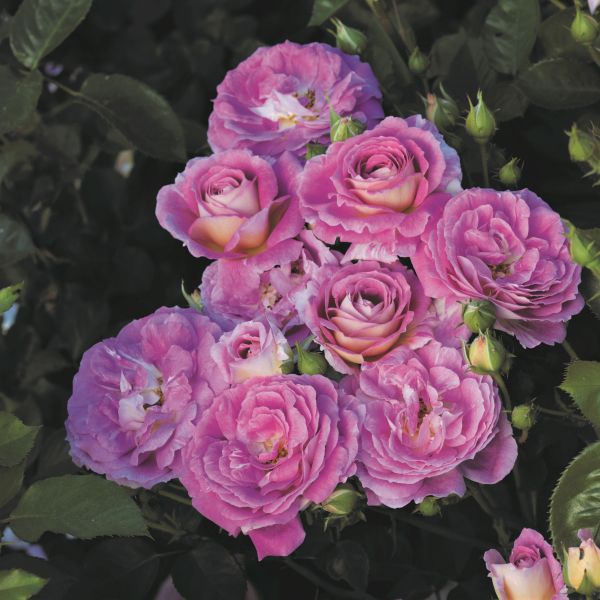
Pink Peace Rose
Rosa 'MEIbil'
52 reviews
Pink Peace Rose
Rosa 'MEIbil'
52 reviews
- Beautiful, fragrant blossoms
- Long-lasting blooms
- Easy to care for and disease-resistant
- Recommended by landscape designers for optimal fit in real yards
$92.00
$132.00
30% Off
- Ships to in 3 to 7 days
- Free Shipping Over $150
- Plant Arrival Guarantee
- In Stock
- Free Plant Consult
$200 - Landscape-Approved: Every Plant We Sell Comes With Design Expertise Behind It
1.5 Gallon
Not just beautiful - intentionally selected by ShrubHub's 3D landscape design team to fit real-world spaces and maximize yard potential.
Why Pink Peace Rose?
The Pink Peace Rose (Rosa 'MEIbil') is a popular choice among gardeners due to its stunning beauty and symbolic meaning. The delicate pink flowers with creamy yellow centers are visually captivating. Additionally, the rose carries a message of peace and love, making it a meaningful addition to any garden. Its hardiness and disease resistance further contribute to its popularity.
People who loved this plant also bought
Sunlight
Pink Peace Roses require full sun, which means they need at least six hours of direct sunlight each day to thrive and produce abundant blooms.
Watering
The Pink Peace Rose typically requires regular watering, aiming for a consistent moisture level in the soil. It is important to avoid over-watering, as it can lead to root rot, while under-watering can result in wilting and stress for the plant.
Fertilizing
The Pink Peace Rose requires a balanced fertilizer with a higher nitrogen content in the early spring and early summer to promote healthy growth and blooming. It is recommended to use a rose-specific fertilizer to meet its nutritional needs.
Pink Peace Rose (Rosa 'MEIbil')
Description:
The Pink Peace Rose, scientifically known as Rosa 'MEIbil', is a stunning and enchanting variety of rose that captivates with its delicate pink hues and elegant blooms. With its classic rose shape and gentle fragrance, this rose variety is a beloved favorite among garden enthusiasts.
Features:
- Color: Delicate pink
- Bloom Shape: Classic rose form
- Fragrance: Gentle and pleasant scent
- Growth Habit: Upright and bushy
- Flowering Season: Repeat bloomer, abundant blooms from late spring to late fall
- Hardiness: Suitable for USDA hardiness zones 5-9
- Mature Size: Typically grows to a height of 3-4 feet and a spread of 2-3 feet
- Uses: Ideal for borders, flowerbeds, and containers
- Resistance: Resistant to diseases
Planting and Care:
The Pink Peace Rose thrives in well-drained soil and requires a location with full sun exposure for at least 6 hours a day. Prior to planting, prepare the soil by enriching it with organic matter and ensuring proper drainage. Water the rose regularly, keeping the soil consistently moist but not overly saturated. Applying a layer of mulch around the base of the plant helps retain moisture and control weeds.
Pruning is essential for the Pink Peace Rose to maintain its shape and vigor. Remove any dead, damaged, or diseased branches as soon as they appear. Light pruning in early spring promotes new growth and encourages abundant flowering throughout the season.
This rose variety is generally resistant to common diseases but it's always recommended to monitor for any signs of pest or disease damage. Applying a balanced rose fertilizer in spring and summer can help promote healthy growth and enhance the plant's overall vitality.
Symbolism and Meaning:
The Pink Peace Rose holds a symbolic meaning of love, joy, and inner peace. Its soft pink color represents grace and elegance, making it a popular choice for weddings, anniversaries, and other special occasions. The gentle fragrance of the Pink Peace Rose emanates tranquility and serenity, creating a soothing atmosphere in any garden or floral arrangement.
Plant Information:
| Botanical Name: | Rosa 'MEIbil' |
| USDA Zones: | 6 - 10 |
| Water: | Moderate |
| Exposure: | Full Sun |
| Soil Needs: | Well Drained |
| Mature Height: | 3 - 5 feet |
| Mature Spread: | 2 - 3 feet |






Pollination Info
Pollination Information for Pink Peace Rose (Rosa 'MEIbil')
The Pink Peace Rose, scientifically known as Rosa 'MEIbil', is a hybrid tea rose known for its large, fragrant, and beautiful pink flowers. Proper pollination is essential for the Pink Peace Rose to produce fruit and seeds, ensuring the continuation of its genetic heritage. Here are some important pollination facts for this rose variety:
Pollination Type
Pink Peace Rose is a self-fertile rose, meaning it can pollinate itself and produce viable seeds without relying on another rose plant for cross-pollination. However, cross-pollination with another rose variety may result in improved seed quality and genetic diversity.
Pollination Method
The Pink Peace Rose is pollinated by various insects, particularly bees and butterflies. These insects are attracted to the rose's vibrant pink petals and delightful fragrance, and they inadvertently transfer pollen from the stamens (male reproductive organs) to the pistils (female reproductive organs) of the same flower or another flower.
Timing of Pollination
Pollination of the Pink Peace Rose typically occurs during the rose's blooming season, which can vary depending on the specific climate and growing conditions. Generally, roses bloom in late spring or early summer, and this is when pollination is most likely to take place.
Encouraging Pollination
To encourage pollination and attract pollinators to your Pink Peace Rose, you can take the following steps:
- Plant the rose in a sunny location with well-drained soil, as this promotes healthy growth and increases the chances of blooming.
- Provide a water source nearby, such as a shallow birdbath or a saucer filled with water. Pollinators need water to thrive.
- Avoid using pesticides or insecticides that may harm or repel pollinators.
Seed Collection
If you wish to collect seeds from your Pink Peace Rose, you can do so once the rose has finished blooming and the petals have fallen off. The rose hips, which are the fruiting structures of the rose, will begin to form. Allow the rose hips to ripen on the plant before collecting them. Once they are fully ripe, you can gently remove the seeds from the rose hips and store them in a cool, dry place for future use.
Conclusion
Understanding the pollination requirements and process of the Pink Peace Rose can help you create an environment conducive to successful pollination and seed production. By ensuring proper pollination, you can enjoy the beauty of this rose and contribute to its preservation for future generations.
FAQ
Pink Peace Rose (Rosa 'MEIbil') FAQ
1. What is the Pink Peace Rose?
The Pink Peace Rose, scientifically known as Rosa 'MEIbil', is a hybrid tea rose cultivar. It is a stunning rose variety with large, fully double blossoms and a beautiful pink color.
2. How tall does the Pink Peace Rose grow?
The Pink Peace Rose typically grows to a height of about 4 to 6 feet (1.2 to 1.8 meters). However, this can vary depending on growing conditions and pruning practices.
3. What is the blooming season for Pink Peace Roses?
Pink Peace Roses typically bloom from late spring to fall, producing an abundance of flowers during this period. The exact timing may vary depending on the climate and geographic location.
4. How often should I water Pink Peace Roses?
Pink Peace Roses require regular watering, especially during dry spells. It is recommended to water deeply once or twice a week, ensuring that the soil is moist to a depth of about 6 inches (15 cm). However, avoid overwatering, as it can lead to root rot.
5. What is the ideal sunlight requirement for Pink Peace Roses?
Pink Peace Roses thrive in full sun, requiring at least 6 hours of direct sunlight each day for optimal growth and flowering. Ensure that the roses are planted in a location that receives ample sunlight throughout the day.
6. How should I fertilize Pink Peace Roses?
It is recommended to fertilize Pink Peace Roses in early spring, just as new growth begins. You can use a balanced rose fertilizer or a slow-release granular fertilizer specifically formulated for roses. Follow the package instructions for application rates and frequency. Additionally, supplementing with organic matter like compost can be beneficial for the overall health of the plants.
7. Are Pink Peace Roses susceptible to any diseases or pests?
Pink Peace Roses can be susceptible to common rose diseases such as blackspot, powdery mildew, and rust. Regularly inspect the plants for any signs of disease and promptly treat them with appropriate fungicides or adopt organic disease prevention methods like regular pruning, proper airflow, and avoiding overhead watering. Additionally, be on the lookout for pests like aphids, spider mites, and thrips, and treat them accordingly using safe insecticidal sprays or natural predators.
8. How do I prune Pink Peace Roses?
Pink Peace Roses should be pruned in early spring before new growth emerges. Start by removing dead, damaged, or diseased wood. Then, prune for shape and size control, cutting back to an outward-facing bud. Additionally, remove any crossing branches or suckers from the base of the plant. Always ensure to use clean, sharp pruning tools to make clean cuts and minimize the risk of disease transmission.
9. Can I grow Pink Peace Roses in containers?
Yes, Pink Peace Roses can be grown in containers. Use a large container with good drainage and fill it with a well-draining potting mix formulated for roses. Place the container in a location that receives ample sunlight, and water and fertilize regularly as needed. Keep in mind that container-grown roses may require more frequent watering and feeding compared to those planted in the ground.
10. Are Pink Peace Roses fragrant?
Yes, Pink Peace Roses are known for their pleasant and strong fragrance. Their scent is often described as sweet and reminiscent of classic rose fragrances. Enjoy the delightful aroma as the roses bloom!
Planting & Care
Pink Peace Rose (Rosa 'MEIbil') Planting & Care
Planting
1. Choose a sunny location with well-drained soil for planting the Pink Peace Rose. The area should receive at least 6 hours of direct sunlight per day.
2. Dig a hole that is twice as wide and slightly deeper than the container of the rose bush.
3. Mix compost or organic matter into the soil removed from the hole before backfilling it partially.
4. Gently remove the rose bush from its container, loosening the roots as needed without causing damage.
5. Place the rose bush in the hole, making sure the bud union (swollen area where the rose was grafted onto rootstock) is level with or slightly above the soil surface.
6. Backfill the hole with the amended soil, firming it gently around the roots to eliminate air pockets.
7. Water thoroughly after planting to provide moisture for the roots to establish.
Care
1. Watering: Keep the soil evenly moist, especially during dry spells. Water deeply at the base of the rose bush rather than overhead to avoid wetting the foliage. Avoid overwatering, as it can lead to root rot.
2. Fertilizing: Feed the Pink Peace Rose with a balanced, slow-release rose fertilizer in spring, just as new growth begins. Repeat this feeding in midsummer. Follow the package instructions for proper dosage.
3. Pruning: Prune the rose bush in early spring to remove dead, damaged, or crossing canes. Maintain an open center to improve air circulation and reduce the risk of disease. Cut back about one-third of the height of the bush.
4. Mulching: Apply a layer of organic mulch around the base of the rose bush to conserve moisture, suppress weeds, and regulate soil temperature. Keep the mulch a few inches away from the stem to prevent rot.
5. Disease and pest control: Regularly inspect the rose bush for any signs of diseases or pests such as black spot, powdery mildew, aphids, or rose slugs. Treat or control them as necessary with appropriate organic or chemical remedies.
6. Winter care: Pink Peace Roses are hardy in USDA zones 5-9. In colder climates, protect the rose bush in late fall by adding a layer of mulch around the base and wrapping it with burlap or a rose cone to prevent winter damage.
Check Out These Verified Customer Reviews:
Customer Reviews
4.7 out of 5 based on 52 reviews
Thank you! Your review has been submitted.
The website was user-friendly and easy to navigate. It was a breeze to place my order for the Pink Peace Rose.
Lovely fragrance.
Great quality blooms.
Item has been added to your cart.






















